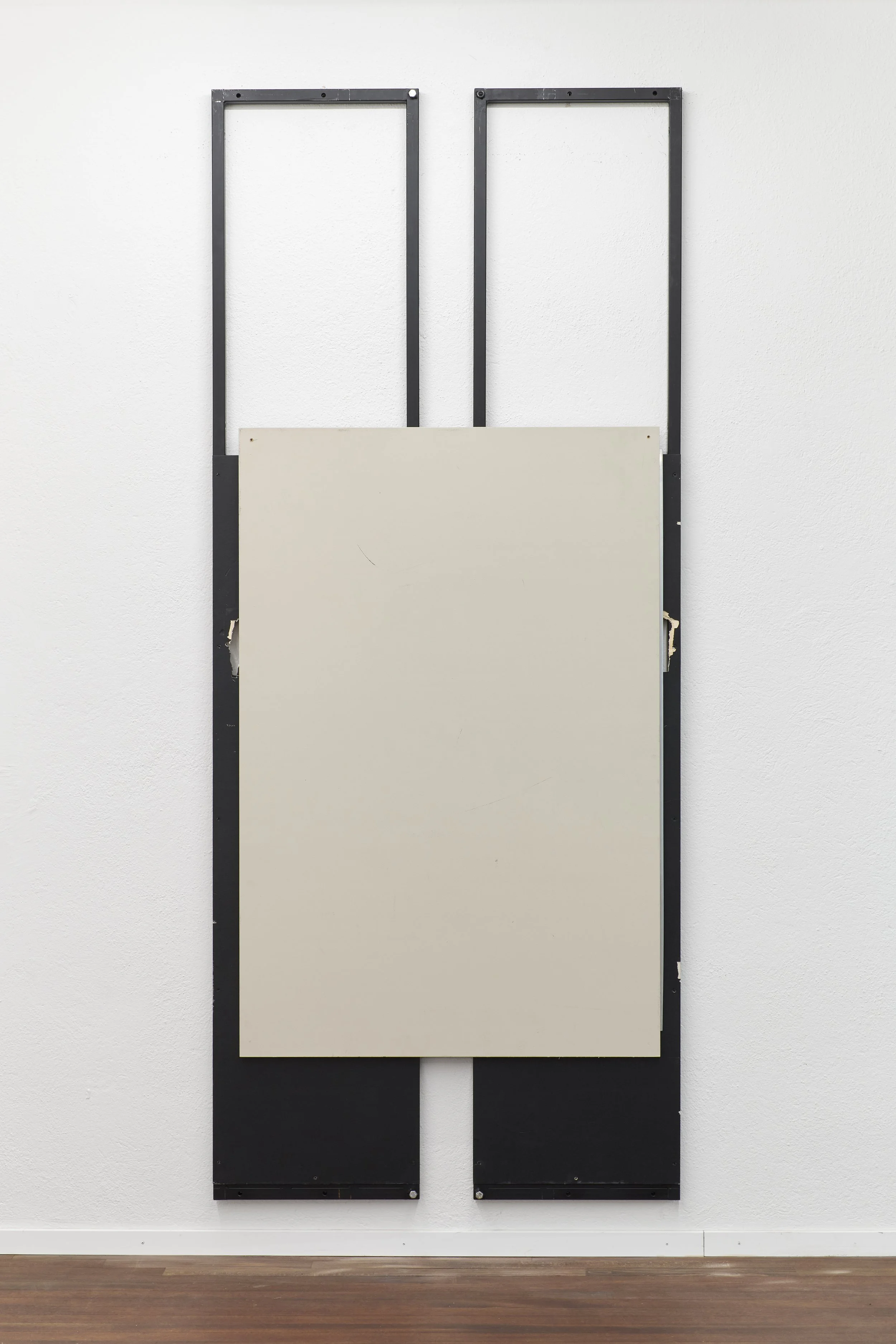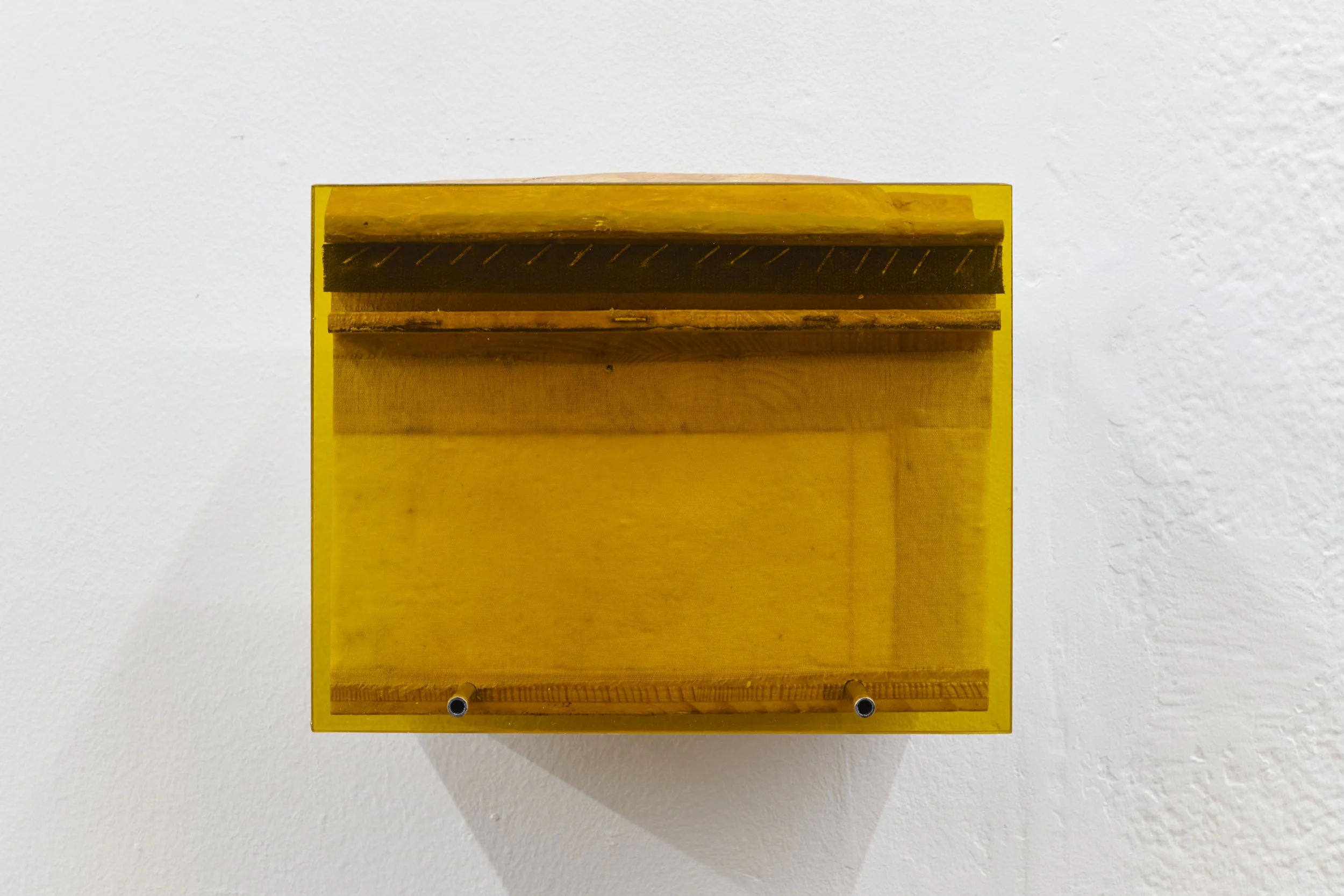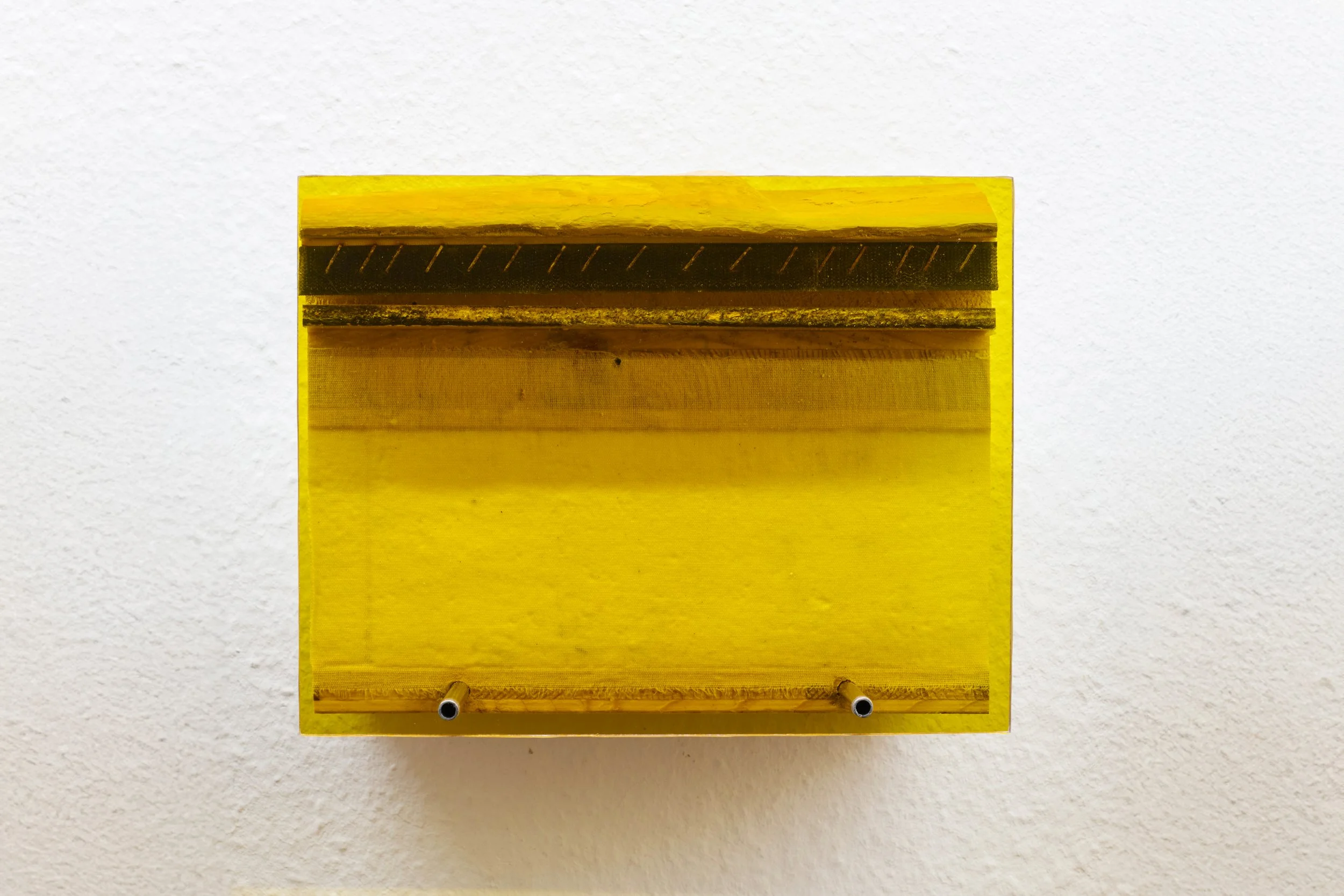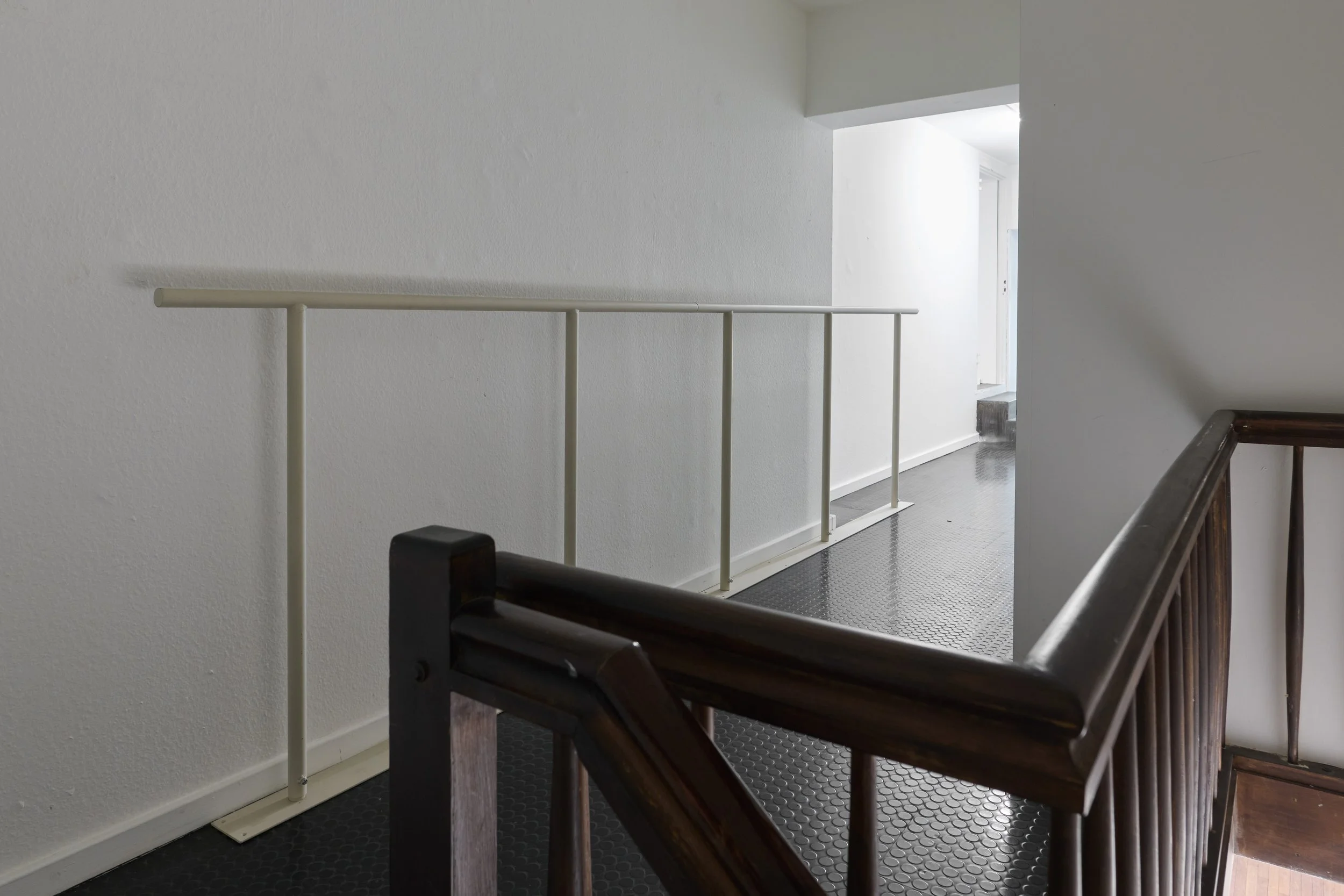PRICE
Odds and Ends
20 September — 1 November 2025
Odds and Ends could be described as a play without actors, orchestrated in two acts and ambiguous atmospheres; it is an exploration of the very skeleton of performativity, revealed through new sculptural works by PRICE, each of which individually carries the struggle of identity formation at a time when self-staging constitutes a paradigm of queer existence.
The first encounter takes place face to face with the back wall of an anonymous stage, empty and neutral, that imposes itself as a blank space of projection and imagination. It acts as the personification of theatrical illusion, which nonetheless cuts off the access to the rest of the exhibition. Soon, you discover that the true actor stands behind this metaphorical fourth wall, in the backstage, where the mechanics underlying the formation of characters and identities are exposed. On the darker reverse of the blank wall, lie the actual remnants of performance: traces of footsteps, and a silly heart drawn beside the pragmatic markings of left and right. One can’t help but ask: what materials convey a performative act? Where does its dramatic resonance linger?
The wall, like all the sculptures in the exhibition, has been fabricated from residues of theatre scenographies from Schauspielhaus Zürich, recovered and rearranged by the artist. Exposed under white light, they no longer serve the illusion of spectacle but transpose their lived experience into a new existence, shifting from props to the very essence of dramaturgy. These sculptural presences persist against the ontological liveness and impermanence of performance. The paradigm is overturned: performativity emerges as the pervasive force that dwells in walls and everyday gestures, defining every single aspect of living, both on and off stage.
On the surrounding walls, the series HC (Hard Cloud) takes shape in various assembled bodies, each of them named after German theatre jargon: eingespielt, durchgespielt, abgespielt and wieder-gespielt stand for the matter that has seen too many stage lights, heard too many musical harmonies and pathos-infused monologues. The materials have acted until exhaustion, until their planned demolition, again and again – what’s left? Perforated and marked panels, identified as discards, are revalued as such by PRICE. These loaded indexes of spectacle are arranged like landscapes of past fiction and wonder that have hardened on the surface under the weight of plays. This hardening presents itself as the real drama, unfolding in real time.
You soon realise you didn’t miss the performance. These performative bodies, bearing the traces of fatigue, reveal another parallel story of the whole show – something evoking underground eroticism in sexual encounters where identities don’t seem to matter so much: an artist’s commentary on a reality where bodies are used as raw material for pleasure and drift away from singular identities. Another series of works presents various alluring figures, spread out like the romantic repetition of a dazzling sunset. But once your gaze passes through the glossy surface, a variety of layers is uncovered. Behind the façade emerges a fake stone with its strata of artificiality – the simulacrum of nature and its true identity as an aestheticised set piece. In the figures of Private Viewing, the glowing orange only partly hides a darker side of romance. The sculptures stand as metaphors for the tension between the flattened space of a surface, as the possibility of performing one’s invented self, and the depth of an identity: the “compulsory self-spectacularization which is the necessary condition of entering the public sphere in the world of late capitalism,” as David Joselit wrote in 2000.
The pervasive scent-work Mille fleur, which diffuses through the space as both prologue and epilogue to the entire play, underscores this tension. Like its sculptural analogues, it is an assemblage of leftovers sourced in Grasse, at the company PCW France, which operates a mass production of perfumes. The non-curated potpourri of thousand-bloom notes – remnants of tests, overproduction, failed products – in this perfume remains ungraspable, uncontainable, morphing with every breath, every current of air; yet everyone individually recognises parts of it, as its different layers recall bodies known in the past. Mille fleur is an ambiguous symptom of the olfactory matter globally disseminated to deodorise intimate personal smells, and of our individual choices of adornments for the sake of seduction. In the exhibition space, this absurd blend of herbal and citrus head notes is unavoidable; you welcome its volatile being – which recalls an orgiastic, unidentified mixture of bodies – simply by the act of breathing.
Ascending to the first floor, you encounter a displaced handrail, an absurd companion for the climb toward the second act: an interlude titled Zwischenpause /Blackout, where the passage through the corridor is accompanied by the toxic air of the exhibition. The head notes give way to floral and woody middle notes, then to a chaotic assemblage of deep musky base notes – the ones that linger longest on the skin. A blackout refers to a break in the spectacle with fade-out lights, but also to a confusion in perception and consciousness induced by substance abuse. Here, it is conceived as a threshold before entering the second act where the atmosphere shifts toward a darker backstage.
The final scene – the acme of PRICE’s drama – is an installation of elements resembling ribbons or ornamental collars placed on a dance floor. They possess an uncanny cuteness: the contradictory mixture of tenderness and aggression, that is ultimately an adoration of a commodity one can touch and possess – an example of how aesthetic pleasure is bound to a form of domination, where capital determines our affects, and desire is tied to ownership. The installation is titled PnP, party and play – a pun on the double meaning of a sexual play where pleasure flirts with danger and theatrical play. This terminology, specific to chemsex practices where the peaks of pleasure are pushed ever higher through substances that intensify ecstasy yet paradoxically render it ever more unattainable, clashes with the baby-blue cuteness of the sculptures. In this last scene of our epic theatre piece, something recalls Kristeva’s notion of the abject – that which cannot be represented, and which threatens the integrity of the subject or the boundaries of the body – which both the perfume and the cuteness attempt to cover. The sculptural bodies merge with each other and individual identities dissolve into a mass of mixed, unidentifiable forms and scents.
The odds and ends of this real-life play are far from trivial or insignificant leftovers. They are the literal spaces and containers of the tragedy of our relentless efforts to locate subjectivity in a capitalist culture of performance. Recovered testimonies, they bear the affect and hopes of each performance and uncover them. Here, no one is the watcher or the watched; the conditions of spectatorship are laid bare and negated, for we are all participants.
Text by Monica Unser

PRICE HC (Hard Cloud) I, 2025 paint, wood, metal 156 x 110 x 9 cm

PRICE HC (Hard Cloud) II, 2025 paint, wood, metal 170 x 120 x 9 cm

PRICE HC (Hard Cloud) III, 2025 paint, wood, metal 267 x 130 x 9 cm

PRICE Private Viewing I, 2025 Plexiglas, wood, metal, paint 39 x 24 x 23 cm

PRICE Private Viewing III, 2025 Plexiglas, wood, metal, paint 39 x 24 x 23 cm

PRICE Private Viewing V, 2025 Plexiglas, wood, metal, paint 39 x 24 x 23 cm







